“El Californio”: The Italian 1860 Army
Early this year, I acquired two Italian 1860 Colt Army .44 caliber cap & ball revolvers. One was a Pietta and while nicely finished, it was unremarkable and not particularly reliable. I corrected its deficiencies, but I just never warmed up to it.
The other 1860 came from a friend in California. It had lain negected for years before he aqcuired it and he cleaned “layer after layer of crud” from gun, the nipples and cylinder. It was loose as a goose he thought it unshootable. He gave it to me as a ‘parts gun’ to the Pietta. It is devoid of markings other than Italian blackpowder proofmarks and a date stamp that indicates 1978. I christened it ‘El Californio’ and sent the Pietta down the road.
A word or two about the 1860 Army Model is in order. This was ultimate evolution of Colt’s cap & ball revolvers. As executed by Colt, it lived up to that standard through the Civil War and Westward Migration. In addition to having the most elegant lines of any Colt ever built, it has the finest single action grip ever contrived.
You can rest assured if I was kicking an old black mustang around the countryside between 1860 and 1872, there would be a brace of ’60 Colts at my side. The last 1860’s were offered in 1873 and many originals are still shootable, some 140 years later. Colt’s reputation, military contracts and future in the marketplace were riding on every gun. Colt understood what parts needed to be hardened, how they needed to be fitted and how to balance the design to keep it from kicking itself apart. It is far more complex than any ’51 Navy, Dragoon or ’58 Remington. I am convinced that if you’re going to have problems with a blackpowder revolver, it will probably be an Italian 1860 Army. Why?
Those sleek lines begin in a very small frame junction and taper upward along the loading lever. It lacks heavy, square frame/barrel junction of the 1851 or Dragoons. Primary support for the 1860’s barrel assembly comes from a perfectly fitted arbor, precise frame/barrel assembly fit and a hardened wedge of the proper taper and dimensions. Now the Italians excel at great food, beautiful women, unique architecture and moderately-interesting sports cars. The usually do a passable job of reproducing almost any American firearm from the Revolution forward.
But they stink at building an 1860. My 1860’s were built 30 years apart and they both wanted to kick themselves loose in four cylinders of shooting. Both of them bent Pietta wedges into horse shoes- wedges that should have been hardened, but weren’t. When these guns shoot loose, they will misfire with boring regularity.
El Californio was long in the arbor, further complicating matters. So I unscrewed the arbor and turned the shoulder back until I achieved an additional half turn into the frame. This set the whole barrel back a substantial distance and other accommodations were needed. I removed 0.011″ from the bottom of the barrel assembly, to set the wedge hole back the proper distance for the shortened arbor. I ordered a hardened Uberti wedge, which required lengthening the wedge opening in the arbor at the front. This is done a few file strokes at a time until the wedge just slipped through the off-side of the frame. This of course set the cylinder back, just a little too far, and I had to file back the corresponding cylinder boss in the frame. Then the cylinder hand wanted to bind up, making cocking difficult and retarding forward motion of the hammer. This was corrected by careful file work on the arbor and frame window. The barrel assembly and cylinder’s relocation 0.011″ to the rear insures the hammer will fire a cap without fail. I reset the arbor in the frame with a generous dose of Loctite Red; and installed the barrel assembly and wedge to keep everything aligned while the Loctite set.
Since the gun was torn down, it seemed a good time to address its cosmetic issues. The brass grip frame was rough and needed a lot of filing and polishing. The steel components required file work, various grades of silicon carbide and steel wool. Believe I’m going to leave it in its natural state and just let it age gracefully, unlike its current owner.
Zeroing
First, we must settle on a load. I decided on 30 grains of Triple Seven with an Ox-Yoke Wonder Wad and .454 Hornady ball. Yes, this is considered a hot load and many will advise against it. It works fine in this tightened-up revolver and it produced the thump needed from a woods gun,
Colt black powder copies invariably shoot high at 20 paces, the theory being that they were intended to be used at battlefield distances against standing or mounted opponents. El Californio wasn’t quite that bad but it was far enough off enough to miss pot meat, junk critters and a brigand’s nose at 25 paces. Setting the arbor back a half turn made it shoot even higher. So it was time to really zero the gun.
This is accomplished by cocking the hammer and filing down the top of it where the sighting notch is located. I file from the front to back, so as not to strain the full-cock notch. You’ll invariably need to file deeper than the notch itself, so stop and file a new one when you get close. This keeps the sighting notch in its original location. You can always open it a little to the left or right to adjust windage, if necessary. This all needs to be done slowly, carefully and with range testing every so often to see exactly what you’ve accomplished.
This pistol started out shooting about 6” high at 7 paces. It is now shooting pretty much spot-on at 25 yards.
With the 1860’s reliability issues worked out and it shooting to the sights, I knew I’d use it for field carry or a backup to old Santa Fe; so I took it to a local harness maker and had him build me a crossdraw for it. It fits the gun in more ways than one.
This old sixgun has carved out a permanent place in my primitive hardware kit.
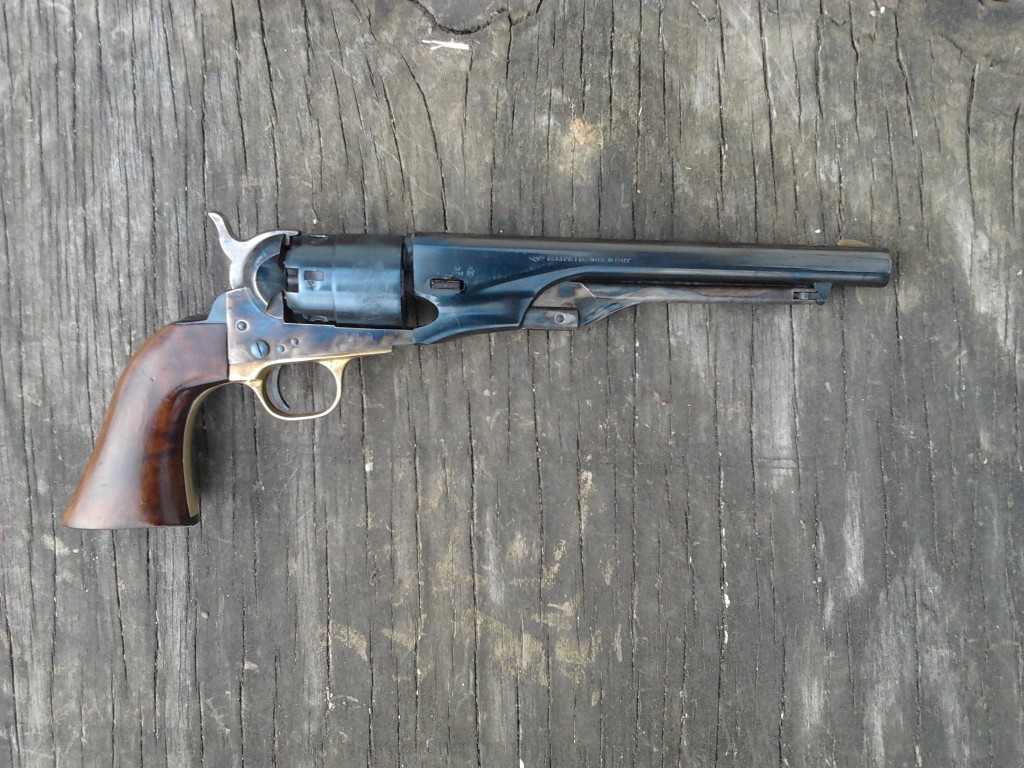
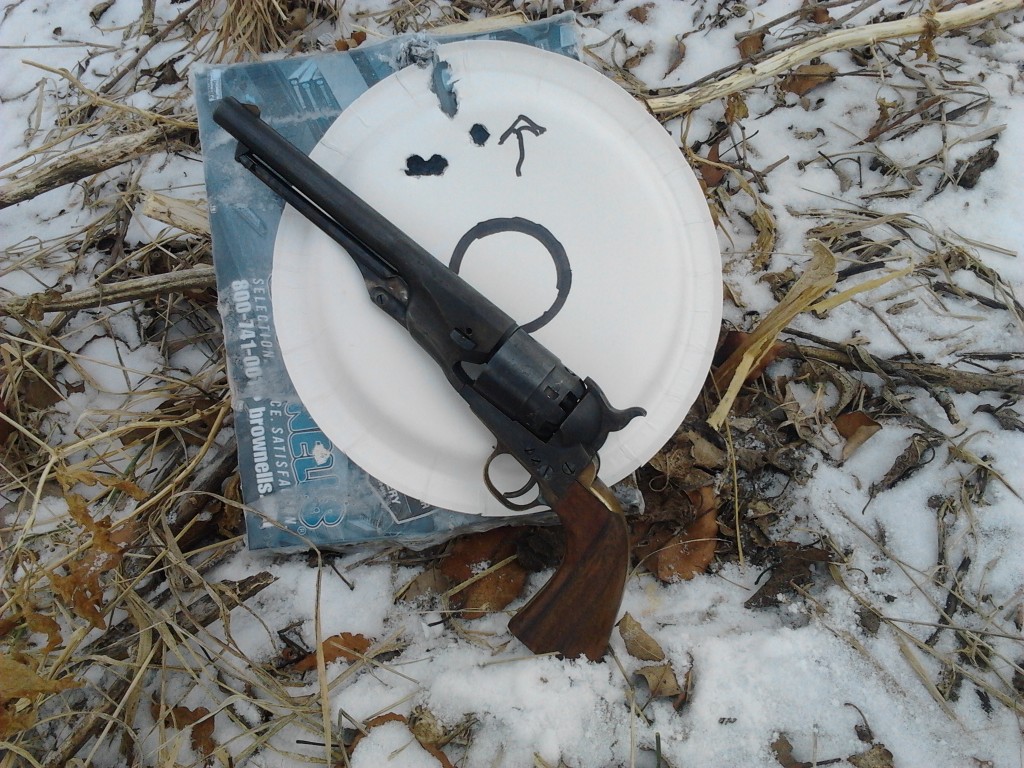
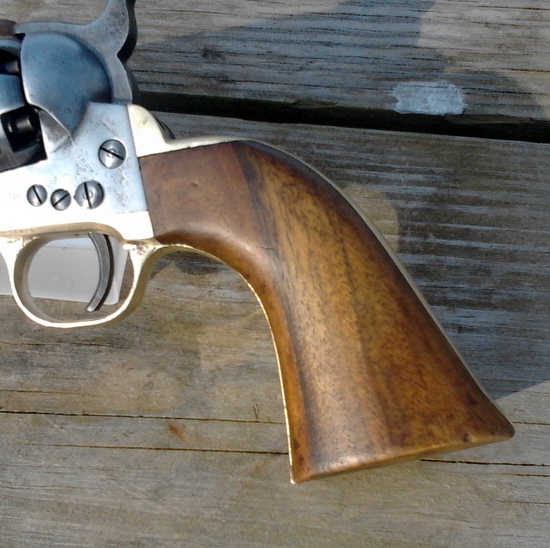
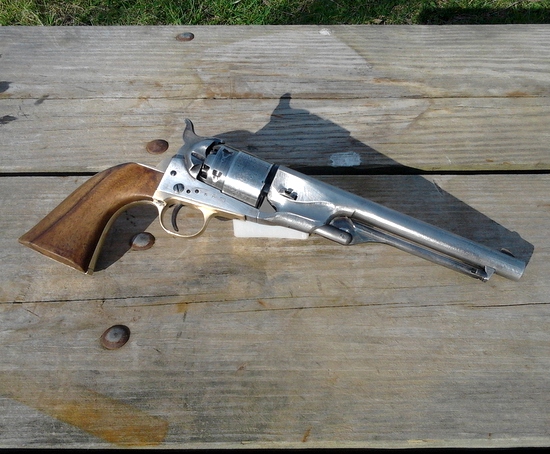
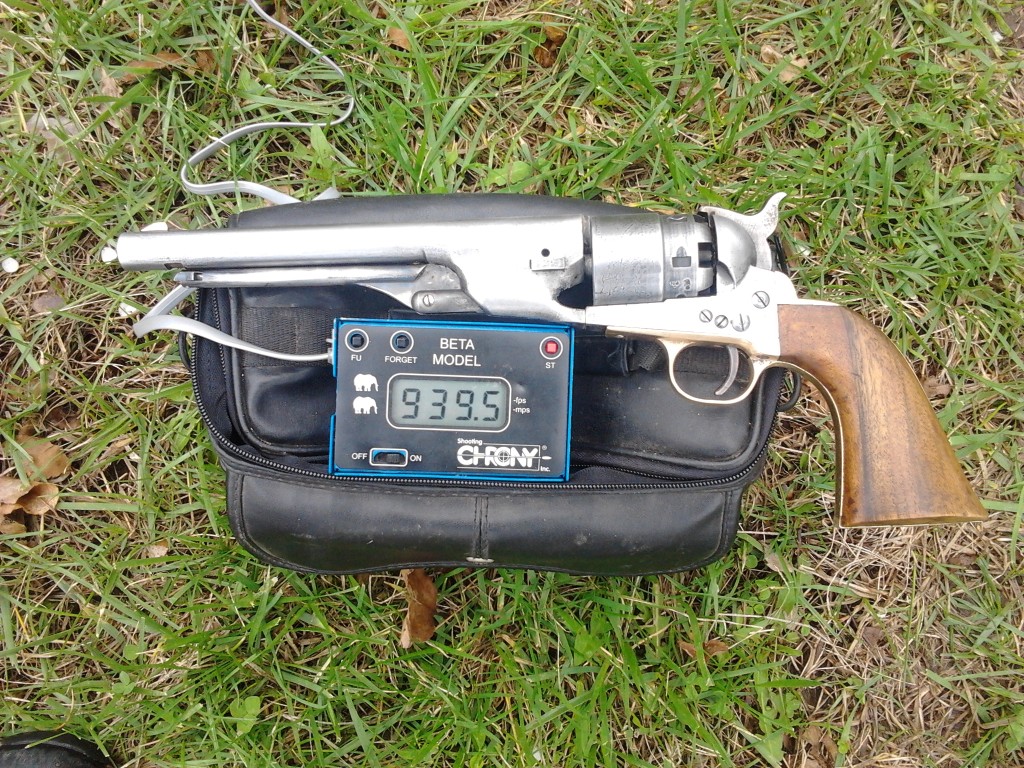
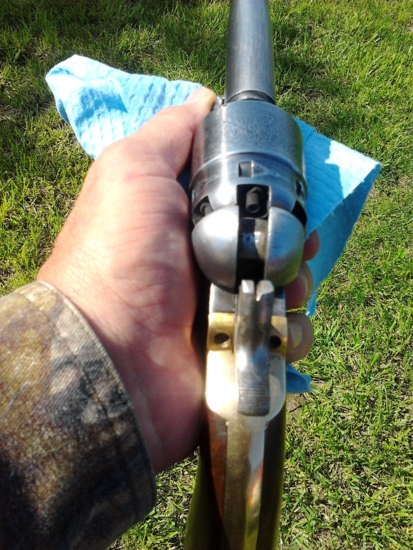
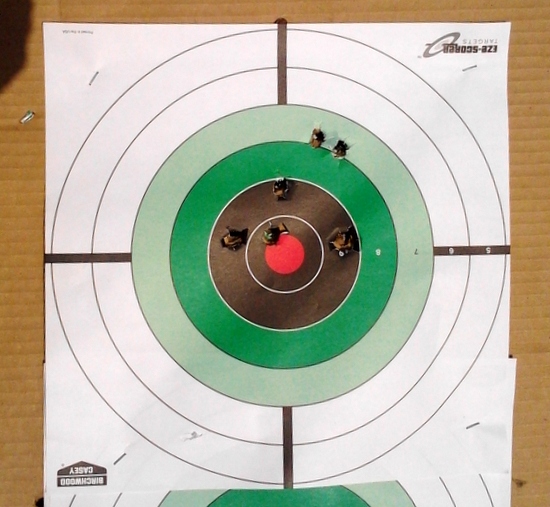
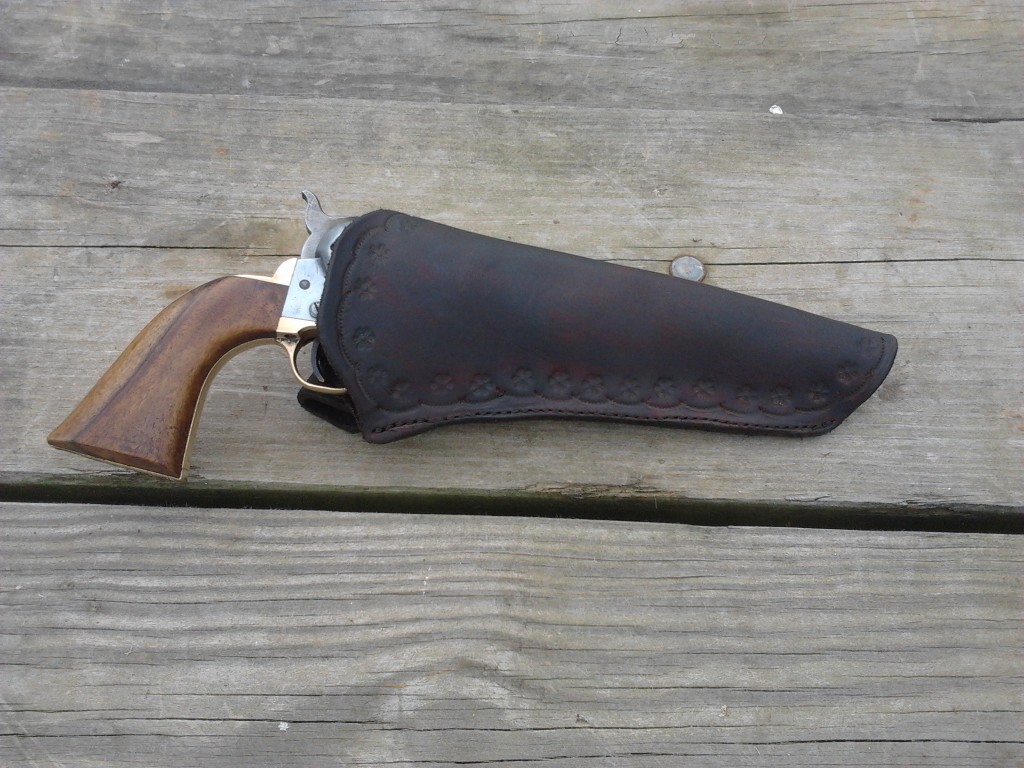
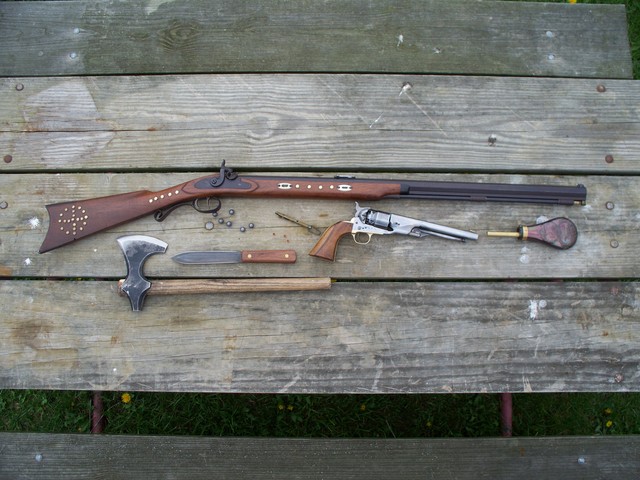

Thomas Tiroff
Great article. I really like shooting black powder myself. What brand is the Hawk you show in the last picture? I think I need one of those.
Thanks, Thomas
Sarge author
Thank you for the kind comments. That’s a Viking Shipbuilder’s Axe from Ragweed Forge, # A-23L at the following link. It is a hell of a good axe. I laid the edge back on mine quite a bit but it will get sharp enough to shave or slice 1/8″ strips off a sheet of printer paper.
Thomas Tiroff
Thanks for the link Sarge. I am a real Hatchet and Hawk fan. They just say “leave me alone or you WILL regret it”.